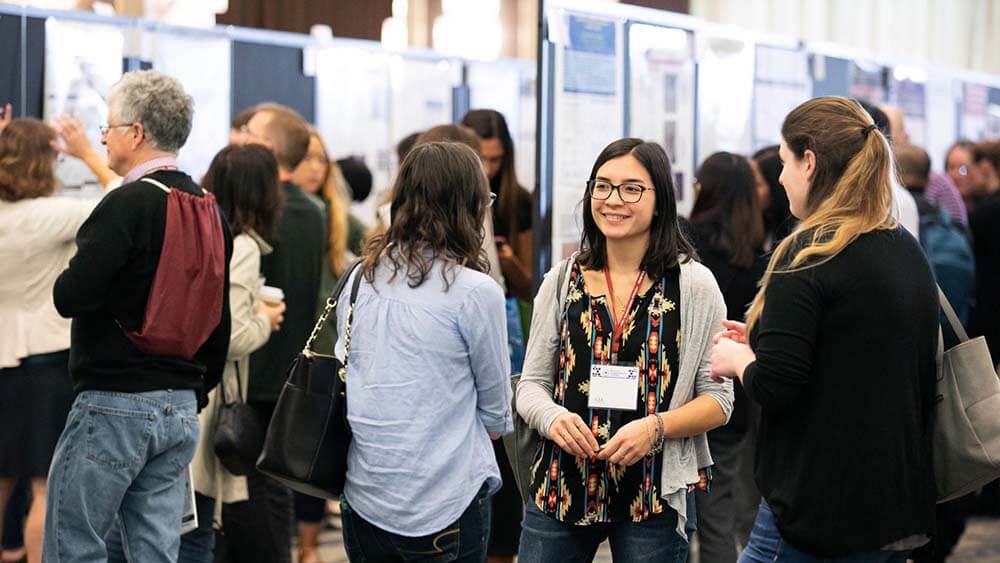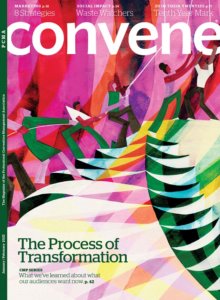
Online poster presentations “just seem to fall short of the in-person experience” at meetings of the Genetics Society of America, said Suzy Brown, GSA’s senior director of meetings. (Courtesy GSA)
Convene editors reached out to a handful of organizations to see how they are incorporating lessons learned from the ways the pandemic affected their audiences, stakeholders, and members into their go-forward strategies. This is one in a series of stories from the January/February issue of Convene.
In early 2020, Suzy Brown, CMP, and her team acted quickly to move the Genetics Society of America’s (GSA) in-person The Allied Genetics Conference (TAGC), scheduled for that April in Washington, D.C., online — breaking new ground for the GSA. Since TAGC — a cross-disciplinary exchange which brings several smaller conferences together — is held only once every four years, it was important that the exchange of ideas between researchers could continue unimpeded, even if participants couldn’t travel or meet face-to-face, Brown, GSA’s senior director of meetings, told Convene in 2020.
One of the biggest takeaways from the experience was how dramatically the online format increased global scientists’ access to conference content — the number of attendees quadrupled, and participation rates grew from 46 countries to 79. When GSA surveyed attendees after the conference, “a number of them said they were only able to attend because it was virtual, because of travel bans, as well as costs,” Brown said at the time. “We want everybody to be able to share their science, regardless of where they’re located geographically or what kind of funding they may have available to them. We will probably always have a virtual component to all of our meetings — not a solely virtual meeting, but we think we will always have a virtual component.”
The next quadrennial Allied Genetics Conference isn’t scheduled until 2024 but here’s what GSA’s conference strategy looked like in 2022: GSA held four hybrid meetings, where most of the content, including keynotes, was streamed and recordings were available to registered attendees for 30 days after the meeting through the meeting app. In 2020, GSA didn’t charge registration fees for the online Allied Genetics Conference; in 2022, complimentary registration was offered to scientists who are full-time residents from low- and middle-income countries through a waiver program.

We had what some might consider strict rules for on-site attendees (vaccinated, boosted, negative test results submitted prior to the meeting, masked in all indoor spaces) but our folks were so happy to be back together in person.”
RELATED: How the GSA Broke new ground in 2020
Presenters could participate virtually or in-person, and whether or not they would be physically present did not weigh into reviews of their abstracts or programming decisions, Brown told Convene via email. GSA did not use digital posters at the in-person meeting, she said. “We have upwards of 1,000 poster presentations at some meetings and digital posters are just not affordable for us on that scale or when trying to replicate the poster-board experience.”
However, all who were chosen for a poster presentation had the option of uploading a PDF with an audio overview to the app, in addition to making more traditional on-site presentations, she said, and online participants could ask questions through the app, Brown said. “Participation varied by meeting, but at least 80 percent of the authors chose to upload a PDF. We didn’t specifically ask if people felt the online option took away from the in-person presentations, but I can say that the poster presentations were always very busy.
“We had what some might consider strict rules for on-site attendees (vaccinated, boosted, negative test results submitted prior to the meeting, masked in all indoor spaces) but our folks were so happy to be back together in person,” Brown added. “We’ve tried poster presentations several different ways and [online presentations] just seem to fall short of the in-person experience. However, we are glad that our meetings are more accessible to those who are unable or unwilling to travel. Giving poster presenters the option of uploading a PDF with an audio overview to share their research just seems to make sense and anecdotally does not appear to take away from the in-person experience.”
Barbara Palmer is deputy editor of Convene.

The Complete January/February CMP Series
- AMDA’s Journey to Meeting Back In Person
- Medical Society Finds Success by Getting Uncomfortable
- How Short-Term Activations Can Create Lasting Positive Change
- Breaking Through the Mindset of Digital vs. In-person Events
- Finding the ‘Sweet Spot’ for Anesthesiologist Group’s Annual Meeting
- Science Group’s Hybrid Meetings Improve Access, Affordability
- Acquisition of a Fan Expo Opens Doors for Nonprofit
